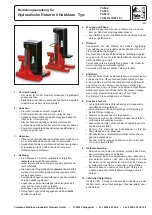
3
SETUP
PLEASE REFER TO THE EXPLODED VIEW DRAWING IN THIS MANUAL IN ORDER TO IDENTIFY PARTS.
1. Spread the arms of the
(#38)
carry
handle
so the holes in the arms
tightly over the lift arm pivot nuts.
2. In most cases the jack should work normally right out of the box, but it is not unusual for air to get trapped in the jack's hydraulic
system during shipping and handling. Symptoms of an air trapped system are a partial incremental pump stroke, jack will not lift a
load, jack will not sustain load, or pumping feels spongy under load.
PURGING AIR FROM THE HYDRAULIC SYSTEM
a. Turn the release valve (located inside #10 Handle Sleeve) in a counterclockwise direction two full turns from its closed position with
the pump handle (#37) provided.
b. Insert the pump handle
in the handle sleeve and proceed to pump the jack ten full incremental pump strokes.
c. Now use the pump handle
to turn the release valve in a clockwise direction until it stops. Put the handle
in the handle sleeve and
pump the lift arm (#5)
up to maximum height.
d. Repeat steps "a" through "c" until all the air is purged from the system.
OPERATING INSTRUCTIONS
This is the safety alert symbol used for the OPERATING INSTRUCTIONS section of this manual to alert you to potential
personal injury hazards. Obey all instructions to avoid possible injury or death.
IMPORTANT:
Before attempting to raise any vehicle, check vehicle service manual for recommended lifting surfaces.
OPERATION
1.
To raise load:
Opening and closing the
release valve is accomplished by engaging the end of the handle with the receiving
slot in the release valve. Turn the handle in a clockwise direction until tight. Position the jack under the load. Proceed to pump
the handle in order to raise the lift arm to the load. As the saddle at the end of the lift arm gets closer to the load, reposition the
Raise the load to the desired work height. Place jack stands of appropriate capacity at the vehicle manufacturers's recommended
support areas that provide stable support for the raised vehicle.
DO NOT CRAWL UNDER VEHICLE WHILE LIFTING VEHICLE
OR PLACING OR REMOVING THE JACK STANDS!
Once jack stands are positioned, turn the handle VERY SLOWLY. Lower the
load to rest on the jack stands. Inspect the relationship between the jack stands and load to make sure the setup is stable and
safe. If the setup is not stable or safe, follow the preceding steps until corrected.
2.
To lower load:
Follow the procedures mentioned in "To raise load" section of the OPERATING INSTRUCTIONS in order to
raise the load off the jack stands. Once the load has cleared the jack stands, remove the stands from under the load and away
from the work area. Turn handle very slowly in a counterclockwise direction until the load is completely lowered to the ground.
Once the jack's lifting saddle has cleared the load, remove the jack from under the load. CAUTION: Keep hands and feet away
from the hinge mechanism of the jack.
DO NOT CRAWL UNDER VEHICLE WHILE LIFTING VEHICLE OR PLACING OR
REMOVING THE JACK STANDS!
PREVENTATIVE MAINTENANCE
This is the safety alert symbol used for the PREVENTATIVE MAINTENANCE section of this manual to alert you to potential
personal injury hazards. Obey all instructions to avoid possible injury or death.
1. Always store the jack in a well protected area where it will not be exposed to inclement weather, corrosive vapors, abrasive dust,
or any other harmful elements. The jack must be cleaned of water, snow, sand, grit, oil, grease or other foreign matter before
using.
2.
The jack must be lubricated periodically in order to prevent premature wearing of parts.
A general purpose grease must be
applied to caster wheels, front axle, elevator arm, handle base pivot bolts, release mechanism and all other bearing surfaces.
Worn parts resulting from inadequate or no lubrication are not eligible for warranty consideration.
IMPORTANT:
In order to
prevent seal damage and jack failure, never use alchol, hydraulic brake
or transmission oil in the jack.
Use hydraulic jack oil,
a light turbine oil, Chevron AW ISO 32 or Unocal Unax AW 150.
3. Every jack owner is responsible for keeping the jack label clean and readable. Use a mild soap solution to wash external surfaces
of the jack but not any moving hydraulic components.
4. Inspect the jack before each use. Do not use the jack if any component is cracked, broken, bent, or shows sign of damage. Do
or the jack is subjected to a shock load, discard the jack and do not use again.
5. Do not attempt to make any hydraulic repairs unless you are a
hydraulic repair person that is familiar with this
equipment.























